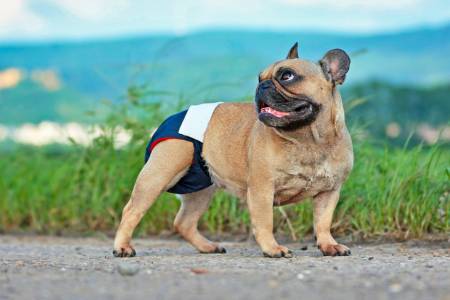Connect with a verified veterinarian in minutes. Licensed vets are available 24/7 to answer your questions. No need to worry about your furry family member.
Did you know that some dogs bleed during their heat cycle? Female dogs may start going into heat when they’re about 6 to 7 months old, though some dogs may start as early as four months of age. Each dog’s heat cycle is unique in some dog breeds.
If you’d like to learn more about dogs and their heat cycle, read on!
Heat Cycles in Female Dogs
Female dogs may go into heat about twice a year. And it’s common for some female dogs to have a bloody discharge during this time. The first stage of heat (also called estrus) is called pro-estrus and usually last anywhere between 4 to 15 days.
A hormone called estrogen causes these changes in the dog’s uterus and vagina. Estrogen also causes the blood vessels in the uterus to enlarge, allowing some red blood cells to leak out of the vessels, causing the bloody discharge. The amount of discharge varies, with some dogs spotting and others bleeding more.
Estrus lasts for about 4 to 8 days, and then ovulation (when the eggs travel from the fallopian tubes to the uterus to be fertilized) takes place. During this time, female dogs become receptive to mating with male dogs. Also, during this time, the bloody discharge may eventually stop.
The end of your dog’s heat cycle is usually the last 7 to 10 days of her cycle. During this time, your female dog’s vulva swells and develops a pink discharge. At this time, she’s no longer receptive to male dogs. Near the final stage, the vulva returns to normal, and the discharge begins to slow down until it ends completely.
How to Prevent Blood Stains on Furniture & Clean Up Bloody Discharge
Some people are alarmed when they find their dog is bleeding. And no wonder! That is cause for concern! However, the bloody discharge during a dog’s heat cycle is normal. The main issue is that the blood may stain furniture, carpeting, and clothing.
You can remove blood stains by soaking them with salty, cold water and then washing them with pet cleaners made with enzymatic ingredients.
It’s also possible to protect your belongings from your fur baby’s bloody discharge. There are doggie sanitary pads available that fit over your dog’s hind end. The pads even have a hole for your dog’s tail to come out! So, she can be comfortable, and your furniture and belongings are protected.

Review symptoms, medications & behavior to keep your pets healthy with a Vet Online in just minutes.
Ask a Vet Live NowFinal Thoughts
If you become concerned about your dog’s symptoms during her heat cycle, we recommend reaching out to the vet. They can help you determine if the issue is normal or whether your fur baby may need to be checked out.
So, be sure to call the vet if you have any concerns or worries when your canine companion’s in heat!
Connect with a verified veterinarian in minutes. Licensed vets are available 24/7 to answer your questions. No need to worry about your furry family member.

Tom
Tom has always loved to write since he was little - he wanted to be either a writer or a veterinary doctor, but he ended up being a professional writer while most of his works are based on animals. He was born in San Francisco but later moved to Texas to continue his job as a writer. He graduated from the University of San Francisco where he studied biotechnology. He is happily married and a soon to be father!
Review symptoms, medications & behavior to keep your pets healthy with a Vet Online in just minutes.
Ask a Vet Live Now

